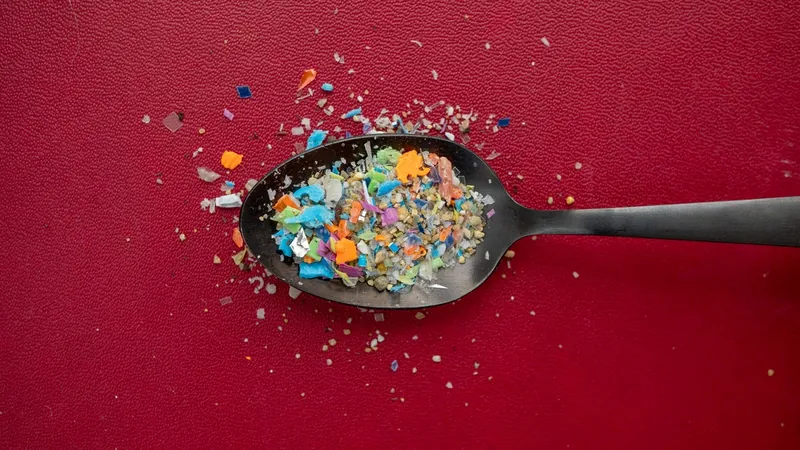
Ditch These 7 Kitchen Items Full of Microplastics to Protect Your Health!
2025-09-15
Author: Amelia
Did you know you're likely consuming tiny particles of plastic in your meals every single day? These insidious bits, known as microplastics, are alarmingly pervasive—lurking in our food, water, and even the air we breathe. Recent studies suggest that our constant exposure might pose a severe threat to our health.
A groundbreaking study from February 2025 revealed that these microplastics don’t just pass through our systems; they can actually accumulate in our bodies. This finding raises urgent questions about potential long-term health complications, as researchers delve into connections with significant health issues.
The Shocking Source of Microplastics: Your Kitchen!
You might be astonished to learn that a major source of microplastics comes from within your very own kitchen. From food wrap to cookware, plastic is integrated into many everyday items. The bright side? You can drastically reduce your exposure simply by making a few conscious changes. Here are the top places microplastics might be hiding!
Are Microplastics Dangerous?
Microplastics are not just an environmental concern; they pose serious risks to our health. An estimated 22 million micro and nanoplastics are inhaled by the average person each year, and they infiltrate our bodies through inhalation, ingestion, and even skin contact. Research indicates dire consequences, including inflammation, potential DNA damage, and links to conditions like heart attacks and strokes.
7 Kitchen Culprits Full of Microplastics!
Here’s a closer look at which common kitchen items are likely contributing to your microplastic exposure:
1. Nonstick Cookware
Use nonstick pans? A study discovered that Teflon-coated cookware releases millions of microplastic particles when heated or scratched. If your pan has a crack, you could be exposing yourself to over two million harmful microplastics each time you cook!
2. Plastic Food Containers
With the surge in food delivery services, plastic containers are everywhere. Unfortunately, heating or washing these containers can leach microplastics directly into your food.
3. Plastic Utensils
Next time you reach for plastic cutlery, consider this: studies show they can release microplastics into your meals, especially when used with hot foods.
4. Tea Bags
Surprisingly, even your cozy cup of tea could harbor microplastics. High temperatures during brewing can release particles from the polypropylene used in many tea bag materials.
5. Certain Spices
That bottle of paprika? It could contain microplastics if it's packaging includes plastic. Recent findings revealed microplastics in every tested plastic spice container.
6. Plastic Straws
Plastic straws are a major concern, releasing microplastics that can even be inhaled. With millions of tons of these straws ending up in our waterways each year, their impact on health and the environment is significant.
7. Canned Food Linings
You might think you're safe with canned foods, but non-BPA linings could still contain microplastics, posing health risks you might not see coming.
Smart Swaps for a Healthier Kitchen!
Fortunately, you can make simple changes to limit your microplastic intake! Consider these healthier alternatives:
- **Switch to Wooden or Stainless Steel Utensils**: Ditch plastic for wooden or stainless steel spatulas and cutlery.
- **Use Glass or Stainless Steel Containers**: These options are safer for your health and better for the environment compared to plastic.
- **Opt for Loose Leaf Tea**: Replace tea bags with loose tea and a stainless steel infuser.
- **Choose Bulk or Glass-Packaged Spices**: This keeps your spices safe from microplastic contamination.
- **Try Reusable Metal or Bamboo Straws**: They’re better for both your health and the environment.
- **Go for Fresh or Frozen Produce**: Choose alternatives to canned goods to skip the plastic linings.
- **Invest in Cast Iron or Stainless Steel Cookware**: Upgrading your pots and pans can significantly reduce exposure.
Conclusion: Protect Your Health!
Microplastics are lurking in many kitchen items, making their way into our food. As scientists continue to study their harmful effects, it’s important to take proactive steps. By swapping out common plastic products for safer alternatives, you can significantly reduce your risk and protect your health!









 Brasil (PT)
Brasil (PT)
 Canada (EN)
Canada (EN)
 Chile (ES)
Chile (ES)
 Česko (CS)
Česko (CS)
 대한민국 (KO)
대한민국 (KO)
 España (ES)
España (ES)
 France (FR)
France (FR)
 Hong Kong (EN)
Hong Kong (EN)
 Italia (IT)
Italia (IT)
 日本 (JA)
日本 (JA)
 Magyarország (HU)
Magyarország (HU)
 Norge (NO)
Norge (NO)
 Polska (PL)
Polska (PL)
 Schweiz (DE)
Schweiz (DE)
 Singapore (EN)
Singapore (EN)
 Sverige (SV)
Sverige (SV)
 Suomi (FI)
Suomi (FI)
 Türkiye (TR)
Türkiye (TR)
 الإمارات العربية المتحدة (AR)
الإمارات العربية المتحدة (AR)